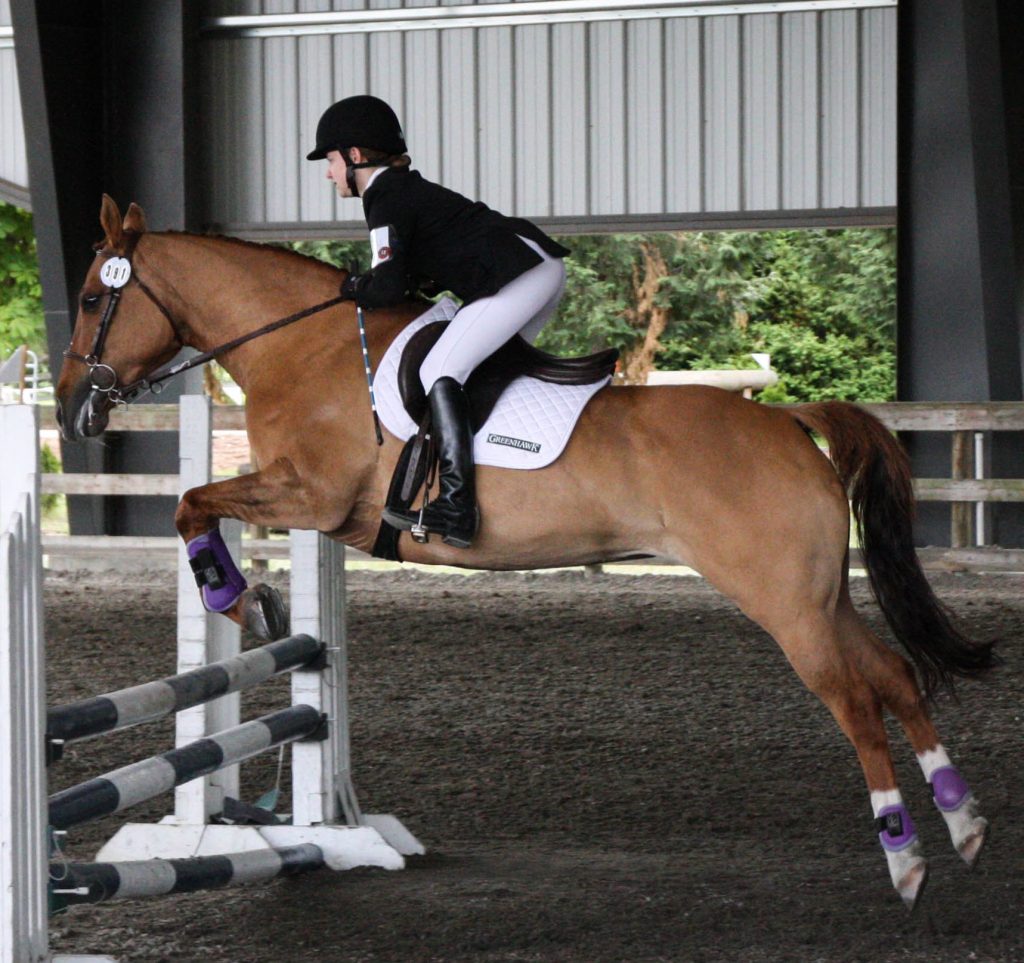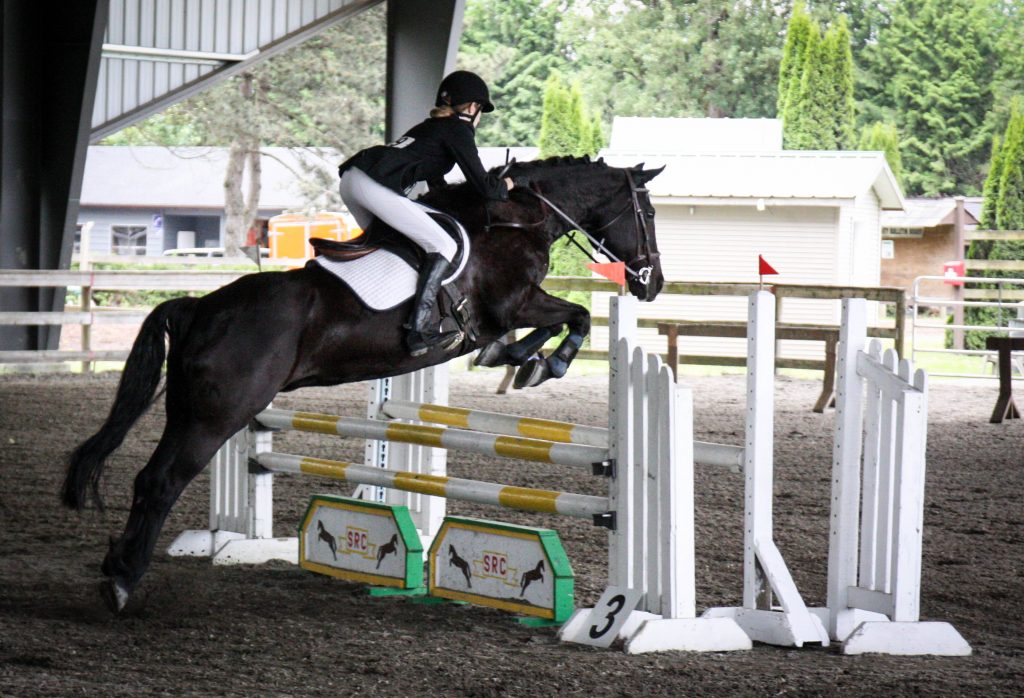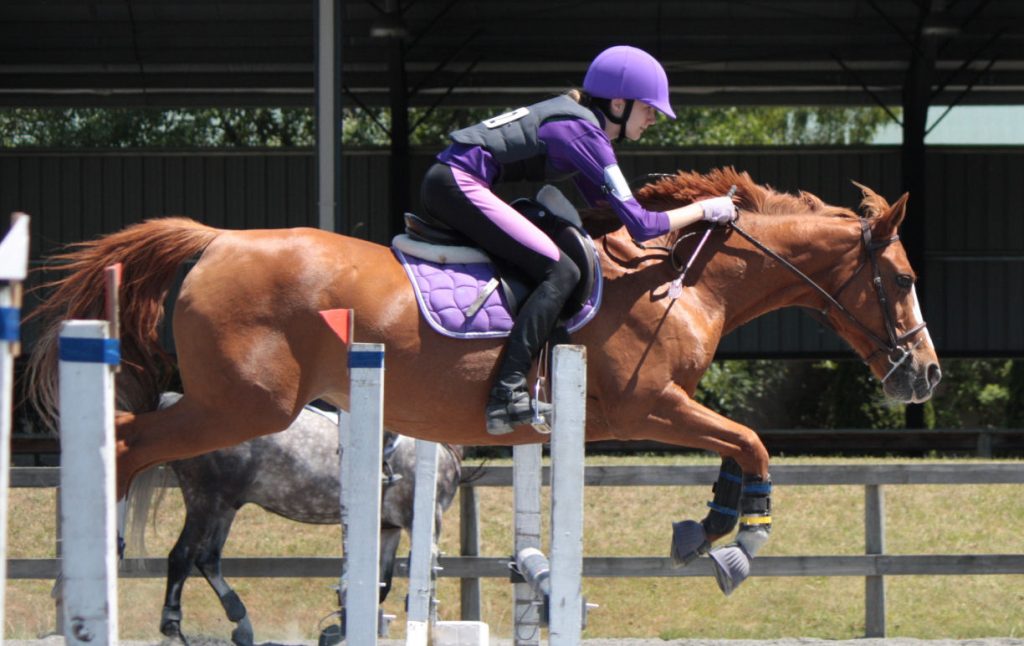Riding Level 4: Stadium Jumping
At level 3 we asked you to jump a couple of cross-rails and navigate some poles on the ground. Four level 4 you will have to ride a
13. Stadium Course 3-4 fences. Verticals, spreads, combinations. 2’ maximum.
A regular course usually has at least eight jumps, so this is in fact only half a course. Part of the reason is due to time. At Level 4 we still test your jumping and flat ride in a single session, so by the time the stadium course comes around we are nearing the end of the test the horses are getting tired and we are generally pressed for time. (At Level 5 you will have separate flat and jumping exams, with the latter including cross country work). However, we still want to see these four fences ridden with good rhythm, pace, and distances, just as if they were part of a full course.
There are any number of books, magazines, and online articles you can find on how to ride a hunter or jumper course, so I'm only going to include a few pointers here.
Ace Your Round
-
- Plan your route. Once you know your course, rehearse it in your head and figure out ahead of time what lead you want to be on for each jump. If you would like to walk the course first you may ask the examiners. However, these fences are low and will be set at easy and obvious distances, so walking the course is probably not necessary unless it helps you mentally.
- Give yourself a good approach. You will have space for a canter circle before you start. As you finish the circle, line your horse up to the centre of the first jump. As you land that one, be looking ahead and riding to the centre of the next.
- Ride a Hunter round. This isn't a timed course, so there is no need to jump at angle or make tight turns. Hugging the rail and cantering at an easy pace will generally give you the most time to make a good approach and take-off spot.

This rider is compensating for the pony's long spot with a supportive crest release and following seat. - Ride the horse you have. Some horses charge the fences and need a lot of management between jumps to steady them. Others require a great deal of encouragement to maintain impulsion. Yet others are clockwork schoolmasters who only ask that you adopt a light seat and hand and stay out of their way. Your seat — deep, half, or two-point — will vary depending on the needs of your horse at various points in the course. You may choose crest or automatic releases. We are not looking for a particular style of riding: only that your riding is sensitive and appropriate for horse and the obstacles.
- Position, position, position. Regardless of the type of seat between fences, you must be balanced in your irons with your weight off the saddle when you are in the air. Using a crest release to help support your weight is perfectly acceptable. Jumping ahead or being left behind are the most common causes for lost marks in this section, along with sitting the landing. These faults make the horse's job more difficult and can even cause mouth or back pain if you are landing heavily in the saddle or jerking on the bit involuntarily.

A beautiful jumping position
Employ help
It's impossible within the scope of a single blog post to convey all the tips likely to help you in this section. That's what your instructor is for. Even if you are an experienced rider it's worthwhile to get some coaching before an assessment. Another pair of eyes is invaluable for fine-tuning this and all the other sections of the test.
Summer Courses
Beginner Riding & Horsemanship
If you’ve never been on a horse, or if it’s been a long time, here’s the place to start. When you arrive at the barn at 11am, you’ll begin with a horsemanship lesson, familiarizing yourself with the horses and their tack, as well as how to groom, handle and tack them up. Then you will have a riding lesson, working through the requirements of Riding Level 1 — the prerequisite to most of the fun stuff we do on horseback!
Saturdays, 4pm – 6pm
15 Jul – 19 Aug
cost: $300 + gst for 6 classes
instructor: Stephanie Laversin
Register here, or bundle with Mounted Combat Fundamentals and save $36.
Riding & Horsemanship Level 2
This course is intended for riders who have taken classes through the program and are comfortable tacking up their own horses. Riders should arrive at 9:30am, to tack up and warm up their horses before starting their riding lessons at 10am, followed by Horsemanship Level 2 or 3 lessons at 11am.
Saturdays, 5pm – 7pm
15 Jul – 19 Aug
cost: $300 + gst for 6 classes
instructor: Stephanie Laversin
Register here, or bundle with Mounted Combat Fundamentals and save $36.
Riding Level 3+
This class is intended for independent riders who have achieved Level 2 or higher. Riders are expected to be tacked up and warmed up prior to class. Your own helmets, boots, and half chaps are recommended, as are safety vests for the occasional cross-country class, weather permitting.
Saturdays, 4pm – 5pm
15 Jul – 19 Aug
cost: $200 + gst for 6 classes
instructor: Stephanie Laversin
Horsemanship Level 3
These classes cover the material for Horsemanship Level 3, including grooming, tack-fitting, nutrition, farriery, vet & first aid, conditioning, and shipping. A level 4 assessment is included at the end of the series. These series are only offered around twice a year, so don’t miss it!
Saturdays, 5pm – 6pm
15 Jul – 19 Aug
cost: $100 + gst for 6 classes
instructor: Kate Landels
Mounted Combat Playday
Sunday 2pm – 5pm
13 Aug
cost: $15 + $15 for use of school horse
Come out and practise your mounted games, sparring, and archery in a fun and friendly environment. Prerequisites are Riding Level 1 for mounted games, Riding 1 + Beginner Horseback Archery for archery, and Green Spur for mounted sparring.
Beginner Horseback Archery
Whether you are an expert rider or archer, or a complete beginner at both, this is your starting point. You will spend about an hour and a half on the ground learning the techniques of Hungarian archery from the Kassai school. After that, you will begin shooting from horseback while our handlers lead your mounts past the targets at the walk. Experienced riders may have the option to try shooting at faster paces without handlers if they are competent and comfortable at the walk.
Sunday 6 Aug, 10am – 1pm
cost: $149 + gst
prerequisites: none
Intermediate Horseback Archery
If you have taken our Beginner course previously and have a minimum of Riding Level 1 or the equivalent this course is for you. Riders with Level 1 will walk and trot, Level 2 Riders will be able to shoot at the canter. Last time we practised multiple targets on canter circles — what will we get up to this time?
Sunday 6 Aug, 2pm – 5pm
cost: $75 + gst
prerequisites: Riding Level 1, Beginner Horseback Archery
Mounted Combat Fundamentals
This 6-week series of classes is intended to give you the basics of swordplay from the ground to prepare you for fighting from horseback. Participants at this level will practise from the ground and the falsemount to achieve the combat skills needed to attain the rank of Green Spur. Students who have their Riding and Horsemanship Level 1 and who attend all five classes can reasonably expect to attain their Green Spur by the end of the series. Once you have your Green Spur, you can sign up for Intermediate Mounted Combat, and can spar in our regular Playday event, as well as competing in our annual Carosella tournament.
Sundays 1pm – 3pm
16 Jul – 20 Aug
cost: $135 + gst for 6 classes
instructor: Aaron Lamontagne
Register here, or bundle with Riding & Horsemanship and save $36.
Ongoing Mounted Combat Mastery classes
These 2-hour sessions focus on the weapons skills needed to progress from Green to Blue Spur. Regular tuition includes classes taken entirely from the ground (no riding skills necessary).
Sundays noon – 2pm
cost: 2 hours tuition
instructors: Jennifer Landels
You can register for classes in person at the front desk, by calling 604 568 9907, or online here.
